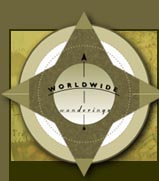|
 Aug 11-14, 1999 Osaka, Japan Aug 11-14, 1999 Osaka, JapanThe
sun's out in force and beating down on our sweaty heads. We hope to seek a brief reprieve
under the shade of an ancient contorted pine that's stretching out just in front of us and
alongside the outer moat of the imposing Osaka-jo Castle. There's a group of middle-aged
Japanese men who've already commandeered the same spot for a relaxing day in the park, and
as we walk up, I manage to make eye contact with one of them. He in turn, does something
that many Japanese could never imagine themselves doing - starting a conversation with a
complete stranger, a 'gaijin' (literally, an outside person) like me no less.
"Konnichiwa" he offers with a smile.
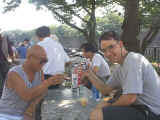 Luckily,
I'm able to reply with one of only a handful of Japanese phases that I've memorized so
far, "Konnichiwa" (good afternoon) I nod in reply. Next thing we know, we're
teaching our new friend Kishi Kazuo the English phrase 'cheers', while he and I each toss
back a glass of a clear liquid that he refers to as 'shochu'. Whew, it's got a little kick
to it! (I later discover that shochu has an alcohol content of about 30%, and was used as
a disinfectant in old Japan). We 'talk' about age, eye color, and travel, using mostly
charade-speak supplemented with an occasional scribbled note or picture. His offer of a
second glass of the stuff from his bottle, prompts me to politely decline, with the excuse
of continuing on our way to get a closer look at the castle towering above and behind us. Luckily,
I'm able to reply with one of only a handful of Japanese phases that I've memorized so
far, "Konnichiwa" (good afternoon) I nod in reply. Next thing we know, we're
teaching our new friend Kishi Kazuo the English phrase 'cheers', while he and I each toss
back a glass of a clear liquid that he refers to as 'shochu'. Whew, it's got a little kick
to it! (I later discover that shochu has an alcohol content of about 30%, and was used as
a disinfectant in old Japan). We 'talk' about age, eye color, and travel, using mostly
charade-speak supplemented with an occasional scribbled note or picture. His offer of a
second glass of the stuff from his bottle, prompts me to politely decline, with the excuse
of continuing on our way to get a closer look at the castle towering above and behind us.
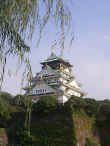 Our
little half an hour 'afternoon tea session' in the park proves to be a suiting
introduction to Osaka, a city that, from what we've read, may arguably offer the best of
modern Japan. And, as we discovered first hand, is probably the least staid, most
laid-back and friendly of Japan's larger cities. We also manage to discover for ourselves
that Osaka is the city with the lion's share of Japan's 'urban personality'. It seems that
Osakans love to enjoy themselves, and as a result, bright and buzzing entertainment
centers have formed in little pockets in and around the city. Our
little half an hour 'afternoon tea session' in the park proves to be a suiting
introduction to Osaka, a city that, from what we've read, may arguably offer the best of
modern Japan. And, as we discovered first hand, is probably the least staid, most
laid-back and friendly of Japan's larger cities. We also manage to discover for ourselves
that Osaka is the city with the lion's share of Japan's 'urban personality'. It seems that
Osakans love to enjoy themselves, and as a result, bright and buzzing entertainment
centers have formed in little pockets in and around the city.
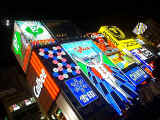 One
such area is the Dotomburi district, where we've dropped in on the action, as it heats up
at dusk. Our guide book interestingly (and accurately) describes this section of Dotomburi
as a 'scene from the science fiction movie Blade Runner'. Sure enough, the miles
upon miles upon miles of twisted neon tubing, covering a dozen or so floors of the
buildings on either of the Dotomburi-Gawi River, almost convince us that we've stepped
into the center of entertainment for some future universe. The array of bright
billboards hypnotically lull us in with their gleaming kaleidoscope of colors, all
dancing, flashing, and vying shamelessly for our attentions. One
such area is the Dotomburi district, where we've dropped in on the action, as it heats up
at dusk. Our guide book interestingly (and accurately) describes this section of Dotomburi
as a 'scene from the science fiction movie Blade Runner'. Sure enough, the miles
upon miles upon miles of twisted neon tubing, covering a dozen or so floors of the
buildings on either of the Dotomburi-Gawi River, almost convince us that we've stepped
into the center of entertainment for some future universe. The array of bright
billboards hypnotically lull us in with their gleaming kaleidoscope of colors, all
dancing, flashing, and vying shamelessly for our attentions.
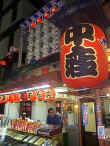 But
a closer inspection reveals implements of enticement from the possible future, and the
past as well. We ramble along, the stark brightness of the neon signs, contrasting with
the much softer light of the chochins (paper lanterns), both mixing somehow to illuminate
our way to the hundreds of pachinko parlors, the hundreds more high-end hi-tech game
rooms, and the literally thousands of restaurants and bars that line the district's
streets. We stroll past stories and stories of them, all crammed into rows and rows of
high-rise buildings. But
a closer inspection reveals implements of enticement from the possible future, and the
past as well. We ramble along, the stark brightness of the neon signs, contrasting with
the much softer light of the chochins (paper lanterns), both mixing somehow to illuminate
our way to the hundreds of pachinko parlors, the hundreds more high-end hi-tech game
rooms, and the literally thousands of restaurants and bars that line the district's
streets. We stroll past stories and stories of them, all crammed into rows and rows of
high-rise buildings.
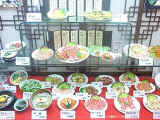 And the name of each bar duly scripted on the building's
directory, with the menu of each restaurant proudly displayed in the building's windows.
Personally, I feel that all Japanese are secretly fun-loving (some very secretly), it's
just that those in Osaka aren't ashamed to show it. Whether it be playing an electro-drum
set and dancing on flashing floor dots in a futuristic arcade in Dotomburi, or sporting
seven inch platform shoes and a 'Girls just want to have fun' T-shirt in Amerika-Mura,
it's obvious that the Osakans are anything but timid about their zest for recreation. And the name of each bar duly scripted on the building's
directory, with the menu of each restaurant proudly displayed in the building's windows.
Personally, I feel that all Japanese are secretly fun-loving (some very secretly), it's
just that those in Osaka aren't ashamed to show it. Whether it be playing an electro-drum
set and dancing on flashing floor dots in a futuristic arcade in Dotomburi, or sporting
seven inch platform shoes and a 'Girls just want to have fun' T-shirt in Amerika-Mura,
it's obvious that the Osakans are anything but timid about their zest for recreation.
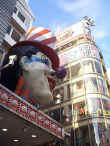 And
Amerika-Mura turns out to be yet another great place for us to people watch, but this
session is during the daylight hours. Filled with mostly younger Japanese, Amerika-Mura's
avenues are facaded with stores and boutiques selling anything, new or used, that is
labeled with, get this, American name-brands! Levi's, Zippo, Mattel, or Playboy,
they love it all. Adornments and clothes, and the more retro the better. Combine these
imported fashions with the latest trendy trinkets plastered with Japanese comic characters
(such as a cell phone hand-strap or wrist-watch with the wildly successful Hello Kitty)
and you have the with-it wardrobe of the average pop-culture centric Osakan youth. A
generation that seems to be fighting hard to advertise their unique personalities in the
'don't rock the boat', 'stay the course', 'for the good of all', notoriously strict
Japanese culture. And
Amerika-Mura turns out to be yet another great place for us to people watch, but this
session is during the daylight hours. Filled with mostly younger Japanese, Amerika-Mura's
avenues are facaded with stores and boutiques selling anything, new or used, that is
labeled with, get this, American name-brands! Levi's, Zippo, Mattel, or Playboy,
they love it all. Adornments and clothes, and the more retro the better. Combine these
imported fashions with the latest trendy trinkets plastered with Japanese comic characters
(such as a cell phone hand-strap or wrist-watch with the wildly successful Hello Kitty)
and you have the with-it wardrobe of the average pop-culture centric Osakan youth. A
generation that seems to be fighting hard to advertise their unique personalities in the
'don't rock the boat', 'stay the course', 'for the good of all', notoriously strict
Japanese culture.
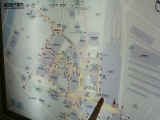 Back towards our hotel, in a section of Osaka called
Kita-ku, we spend the next few hours wandering the maze of underground malls and
passageways that seem to sprawl for miles beneath the busy street level of almost the
entire district. We pop-in for a little afternoon pick-me-up in one of Japan's numerous
'coughing', I mean 'coffee', shops. A quick sojourn into one of these smoky cafes would be
enough to convince any hot-shot management consultant that the secret to this Asian
powerhouse's stellar success, is what he might well dub 'Japan's three C's'. Back towards our hotel, in a section of Osaka called
Kita-ku, we spend the next few hours wandering the maze of underground malls and
passageways that seem to sprawl for miles beneath the busy street level of almost the
entire district. We pop-in for a little afternoon pick-me-up in one of Japan's numerous
'coughing', I mean 'coffee', shops. A quick sojourn into one of these smoky cafes would be
enough to convince any hot-shot management consultant that the secret to this Asian
powerhouse's stellar success, is what he might well dub 'Japan's three C's'.
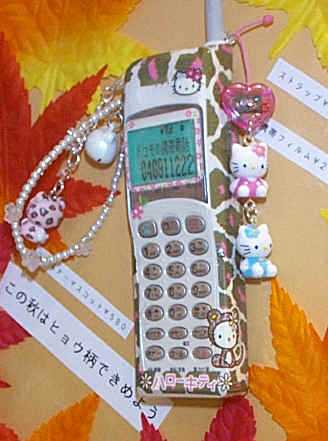 Across all age groups, cell phones, coffee,
and cigarettes seem the lifeblood of the country. Between giggles, the two young
girls at the table next to ours, sip their café latte and puff on their Hope brand
cigs, while comparing photos of their trip to Tokyo Disney. In their pictures, I can't
help but notice yet another Japanese idiosyncrasy - each one of their photos showcase one
of the two of them as the centerpiece. It must be a national law that any pictures, taken
here or abroad, have at least one Japanese standing in front of whatever it is that's
being photographed. Across all age groups, cell phones, coffee,
and cigarettes seem the lifeblood of the country. Between giggles, the two young
girls at the table next to ours, sip their café latte and puff on their Hope brand
cigs, while comparing photos of their trip to Tokyo Disney. In their pictures, I can't
help but notice yet another Japanese idiosyncrasy - each one of their photos showcase one
of the two of them as the centerpiece. It must be a national law that any pictures, taken
here or abroad, have at least one Japanese standing in front of whatever it is that's
being photographed.
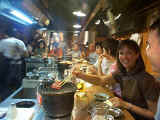 And paragraph two of the same page of legislation probably reads:
'everyone within the ages of 14 and 44 must own at least one cell phone, and use it as
often as possible'. This edict's evidenced by three other girls relaxing at the table to
our opposite side. They're all wrapped up in engaging conversation - although not with
each other, but each with their own cell phone callers. Yep, from the digital phone
disciples in Kita-ku, to the blaring verses of Living in America and Play That
Funky Music White Boy in the shops of Amerika-Mura, to the intense arcade
air-guitarists in Dotomburi, to the friendly boozers in Castle Park, Osaka definitely gets
our vote for the city with the biggest share of Japan's 'urban personality'. And paragraph two of the same page of legislation probably reads:
'everyone within the ages of 14 and 44 must own at least one cell phone, and use it as
often as possible'. This edict's evidenced by three other girls relaxing at the table to
our opposite side. They're all wrapped up in engaging conversation - although not with
each other, but each with their own cell phone callers. Yep, from the digital phone
disciples in Kita-ku, to the blaring verses of Living in America and Play That
Funky Music White Boy in the shops of Amerika-Mura, to the intense arcade
air-guitarists in Dotomburi, to the friendly boozers in Castle Park, Osaka definitely gets
our vote for the city with the biggest share of Japan's 'urban personality'.
|
